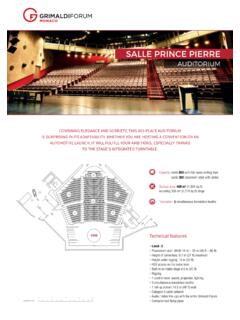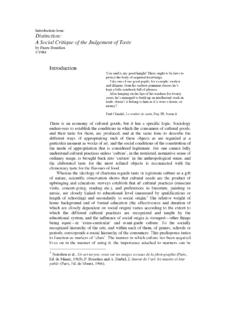Transcription of aguidetounderstanding pierre robin sequence
1 A publ ica ti on of chi ldre n s craniofacial assoc iationa gu id e to un ders tand ingpierrerobinsequencea gui de to unde rstandi ngpier re robin se quencethi s paren t s guid e to Pi erre Robi n Se quenceisdes ig ned to answ er ques tio ns th at ar e frequentlyas ked by par ents of a childwith PierreRobinSequ ence . It is intendedto providea clearerunder-st andi ng of the conditionfor patients,parentsandoth er s. 2 008 Ch ildr en s Craniofacial Ass ociation,Dallas,TXThe inf or mat io n providedhere was wr it ten byRichard J. Redett,MDThi s bookletis int endedfor inf ormation purposeson ly. It is not arec om mendationfor tr for tre atmentshouldbebas ed on mu tual agreementwith th e craniofacia l mp li cation s sh ou ld be dis cus sed with th e ph ysicianprio r to andth rou gho ut tr eatm ent .Des ign an d Pr odu ctionby robin Williamson, WilliamsonCreativeServ ices , Inc.
2 , Carr ollton, at is pie rre robi nseq uenc e?in 1923 , a ph ysiciannamedPierreRobindescribeda newbornchil d wi th an ab normally smalllowerjaw (mandible) , largeton gue an d breathingpro blems . Tod ay , PierreRobi n sequence (PRS) is acon di tion of facialdi fference ch arac terizedby severeun der development of the lowerjaw (retrognathia),a downward or backward-posi tio ned tongue(gl os sopto si s), respi ratoryobs tructi on, and usuallyacl eft palate(op enin g in th e roof of th e mouth).Normally, betw een ni ne to el evenweeksofges tati on, th e ton gu e mo ves downand awayfromth e roo f of the mo uth. Thi s al lows spacefor thesi de s of the pal ate to shi ft to the mi dlineand wever, in PR S the smal l lowerjaw keepstheto ngue po sitio ned hi gherin the mou th thannormal,th erebyinte rferingwi th the no rmal closureof thepal ate.
3 This typ icallyresul ts in a wi de U-shapedcleftof th e soft and part of th e hardpal y is pie rre robin called aseq uenc e and not asyn drome ?pRS is calleda seq uencean d not a syndromebec aus e the und er devel opedlow er jaw begi nsa sequ enceof events, whic h leadsto the abnormaldi sp lacement of th e tong ue and sub sequentfo rmati on of a cleft at cause s pi err e robinseq uenc e?the exactcau se of PR S is not kno wn. Ex ternalfactors, wh ich cr owd the fetusand interfere wi thth e gro wth of th e lowerjaw, may contributeto tain neu ro log ical condi tio ns whic h lead todec reas ed jaw mo vement in utero , can also restrictjaw gr ad di tion , so me stud ies demonstrateth ere may be a genetic bas is for is PRS di agnosed?the diag no sis of PR S is madeby ex am iningtheinfantan d not by spec ial diag nos tic at ar e the cha nc es of mybab y hav ing PRS?
4 The overall incid enceof PierreRo bin sequence islow , appr oximatelyone in 8, 500 to 14, S is equally co mmonin malesand fe a high er incid enc e of PRS in twin s, whic h may bedu e to cr owd ing in the uterus, therebyrestrictinggro wth of the lo wer ll my child pa ss PRS on tohis/ he r childre n?if an ind ivid ual has PRS bec aus e of the influence ofexter nal fa ctorswhi le in utero , hi s or her risk ofpas sin g on th e conditio n is min imal , bec aus e thegen etic infor mationgov erni ng jaw and palatedev elop men t has not beenal tered .In is ol ated caseswhere PR S is not as soc iatedwithan y othersyn dr omes, the ri sk of a parenthav ingan other chi ld with PR S is th ree to five perc ent. Theri sk of an adu lt with isol ated PRS havinga childwithcl eft palateis als o th ree to five perc ent.
5 Genetictes tin g may be offeredif a geneticsy ndromeissu spec ted . Chr omosome analy si s an d testingforchr omos ome deletion (FI SH for del etionof 22q11)can be PRS see n in othersyn drome s?pRS can be seenin other sy ndromes incl udingSti ckleran d Velo cardi ofac ial sy cklersynd rome is the mo st commonsy ndromeas soci ated with PR S. It oc curs in 10 to 30 percentofcases . Stic kle r synd ro me is a geneticmalfunctioninth e ti ssu e that co nnectsbones, heart,eyes and ears .So meo ne with Stickl er syn dromemay hav e problemswith vis ion, hearing, bonesand joi nts, the heartandfac ial formation, incl udi ng cleft pal locar di ofacialsyndromeis as soci ated with PRSin appr oxi mately10 percentof cases . The mos tcom monfeatu res of this sy ndromeare cleft pa late,heartdefect s, characteri sti c fac ial appearance,mi nor lear nin g prob lems,and speechand feedingpro blems.
6 4wh en is the cle ft palaterep aired?the cleft palateis us uall y rep airedwh en an infantis betweennin e and twel ve months old, depend-in g on the healthof the chi ld . In PR S, surgerymaybe pos tpo ned a mo nth or two if the lowerjaw andmo uth ar e very small . Palatesurgerytakesabouttwoor three hours, with the infantstayi ng in the hospitalon e or two nigh chi ld with PRS may spendhis /her first ni ght afterpal ate surge ry in th e pediatric intensive care unit inord er to watchfo r signs of ai eft palatecan resul t in ab normaliti es with themi ddle ear , lead ing to persi stent flui d. This is apri marycauseof rep eat ear infec tion s. Repeatearin fections and persis tent mid dle ear fluid may resultin heari ng lo ss. Tub es can be insertedinto the ear atth e ti me of palaterepai r to al lev iate flu id build-upan d res tor e heari ng.
7 Mos t ch ild ren havenormalspeech afterpalaterepair, bu t so me wil l requi re sp eechth erapyor asecond oper atio n later on to improve aus e of the co mpl exi ty of Pi erre RobinSequencean d cleftsof th e pal ate, PRS shoul d be diagnosedan d treatedby an exp eri enc ed teamof at othe r problemsmightwe expe ct and how will theybe trea te d?two pr obl ems you mi ght ex pect to deal with inPierr e Rob in Seq uenc e are feedi ng di fficultiesandresp iratorypr ob ry newborn wi th PRS will experienceso me deg ree of feedingdi fficu lty. Thi s is bec auseofa combination of factors, inc ludi ng th e size of thelo wer jaw , position of the ton gue and the cleft ofth e mi nor deg rees of PRS canlear n to feed with speci all y adap ted nipplesandbo ttles such as th e HabermanFeeder,the MeadeJo hns on Cle ft PalateNurs er , or a regularnipplewitha larger open ing.
8 A feedi ng cons ultan t can oftenhel p par ents cho ose the ri ght ni ppl e/bo ttl e combina-ti on thr oug h a course of trial and error .Fo r infan ts with moresev ere PRS, the risk of aspi -rati on (i nhaling fluid into the lu ngs ) duringfeedingcan be hig h. In addi tion,the babymay struggletomo ve milk to the back of the th ro at and swallow,whi le tryi ng to br thi s case significantcaloriesfo r weightgain can be los pr eventasp irationdurin g feedi ng and to allowth e chil d to gain wei ght app ropri ately,a feedingtu be (nas oga stric tubeor NG tu be) may be insertedin to the nose and do wn in to the is asafe pr oced ure an d is a temp orarysolutionthat canbe used up to a mon dr en wh o requi re long -termfeed ing assistancemay need a gastrictu be surg ic all y ins ertedthroughth e ab domi nal wall in to the PRS ou tgr ow theirfeedi ng pro bl ems whenthemandibl e gr ows mo re suffic ien tly.
9 Thi s usuallyoc cursby one to two yearsof pro blemscan be commonin infantswi thPR S. A normal-sizedlowerjaw help s to anc hor theto ngue in a mor e forwardpos iti on. Becauseof thesmall , rec essedjaw foundin chi ldren with PRS, theto ngue tend s to fal l bac kwardswhenth e chi ld ispl acedon his/ her back. Wh en the ton gue fallsbac kwards it blo cks of f th e throatand is is of great co nc ern du ring sl eep, whentheto ngue is mo re relaxedan d proneto fall bac k intoth e th ro at. The maj ori ty of bab ies res pondwell topo sitio ning on the sto mac h wh ich helpspull theto ngue forw ard duri ng sl eep. Other infantsmayrequi re nasa l tu bes or surgeryto pu ll or pushtheto ngue forw ard .So me hospital s may try po si tio nin g the infantonhi s/ her stom ach. If thi s wo rks to rel iev e the respirato-ry obs truction, infantscan safelybe sen t homewithan ap nea mo nito r (a moni tor that al erts the parentswhe n br eathing is interrupted).
10 If stomachpos ition ing does not workat reliev ingth e res piratory ob struction, a nasop haryngealairwaymay be passedth roughthe no se into the upper7ai rw ay to he lp with breathing. A nas al airwaycan beus ed for a shortperiodof as ional ly a sleepstu dy will be don e pri or to dis charge fro m theho spital . This in sur es the chil d is safe to be sentho me without risk of sig ni fican t ap r thos e infan ts with mo re severerespiratoryob struction, su rg ical procedures may be requiredtoimp ro ve br eath ing . For chil drenwh ose breathingob struction is no t reli ev ed by pronepositioning, ato ngue-l ip adh esio n may be rec tong ue-lipad hesionis a safe proc edurewhi chtemporarilysu tur es th e ti p of th e tongueto thein si de of th e lowerli p therebypul li ng th e tonguefo rw ard an d out of the bac k of the th ro at.




